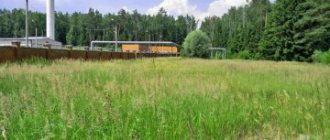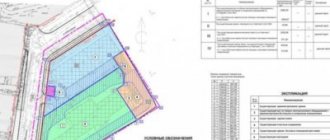Types of permitted use of industrial land
| Name of the type of permitted use of the land* | Description of the type of permitted use of the land** | Code (numerical designation) of the type of permitted use of the land*** |
| 1 | 2 | 3 |
| Production activities | Placement of capital construction projects for the purpose of subsoil extraction, their processing, and industrial production of things. The content of this type of permitted use includes the content of types of permitted use with codes 6.1-6.9 | 6.0 |
| Subsoil use | Carrying out geological surveys; subsoil extraction by open (quarries, dumps) and closed (mines, wells) methods; placement of capital construction projects, including underground ones, for the purpose of subsoil extraction; placement of capital construction facilities necessary to prepare raw materials for transportation and (or) industrial processing; placement of capital construction projects intended for housing of employees performing maintenance of buildings and structures necessary for subsoil use purposes, if subsoil extraction takes place in an intersettlement area | 6.1 |
| Heavy industry | Placement of capital construction projects in the mining and processing and mining processing, metallurgical, mechanical engineering industries, as well as the manufacture and repair of automotive products, shipbuilding, aircraft manufacturing, mechanical engineering, machine tool manufacturing, as well as other similar industrial enterprises, for the operation of which the establishment of security or sanitary protection is provided zones, except in cases where the industrial facility is classified as another type of permitted use | 6.2 |
| Light industry | Placement of capital construction projects intended for the production of textiles, clothing, electrical (electronic), pharmaceutical, glass, ceramic and consumer goods | 6.3 |
| Food industry | Placement of food industry facilities for processing agricultural products in a way that leads to their processing into other products (canning, smoking, baking), including for the production of drinks, alcoholic beverages and tobacco products | 6.4 |
| Petrochemical industry | Placement of capital construction facilities intended for the processing of hydrocarbon raw materials, the production of fertilizers, polymers, chemical products for household use and similar products, as well as other similar industrial enterprises | 6.5 |
| Construction industry | Placement of capital construction facilities intended for the production of: building materials (bricks, lumber, cement, fastening materials), household and construction gas and plumbing equipment, elevators and lifts, carpentry products, prefabricated houses or parts thereof and similar products | 6.6 |
| Energy | Placement of hydropower facilities, nuclear power plants, nuclear installations (except for those created for scientific purposes), storage facilities for nuclear materials and radioactive substances, thermal stations and other power plants, location of service and auxiliary structures for power plants (ash dumps, hydraulic structures); placement of electric grid facilities, with the exception of energy facilities, the placement of which is provided for by the content of the type of permitted use with code 3.1 | 6.7 |
| Connection | Placement of communication facilities, radio broadcasting, television, including aerial radio relay, overhead and underground cable communication lines, radio lines, antenna fields, amplification points on cable communication lines, satellite communications and television and radio broadcasting infrastructure, with the exception of communication facilities, the placement of which is provided for by the content of the type of permitted use with code 3.1 | 6.8 |
| Warehouses | Placement of structures intended for temporary storage, distribution and transshipment of cargo (except for the storage of strategic reserves) that are not parts of the production complexes where the cargo was created: industrial bases, warehouses, loading terminals and docks, oil storage facilities and oil loading stations, gas storage facilities and gas condensate and gas pumping stations, elevators and food warehouses serving them, with the exception of railway transshipment warehouses | 6.9 |
| Providing space activities | Location of cosmodromes, launch complexes and launchers, command and measurement complexes, centers and flight control centers for space objects, points for receiving, storing and processing information, storage bases for space technology, landing sites for space objects, experimental base facilities for testing space technology, centers and equipment for training cosmonauts, other structures used in space activities | 6.10 |
| Transport | Placement of various types of communication routes and structures used for the transport of people or goods, or the transfer of substances. The content of this type of permitted use includes the content of types of permitted use with codes 7.1 -7.5 | 7.0 |
| Railway transport | Placement of railway tracks; placement of capital construction facilities necessary to ensure railway traffic, boarding and disembarking passengers and their related services, including railway stations, railway stations, loading docks and warehouses (with the exception of warehouses for fuel and lubricants and gas stations of any type, as well as warehouses intended for storage of hazardous substances and materials); placement of ground-based metro structures, including landing stations, ventilation shafts; placement of ground structures for tram service and other special roads (cable cars, monorails) | 7.1 |
| Automobile transport | Placement of roads outside the boundaries of a populated area; placement of capital construction facilities necessary to ensure road traffic, boarding and disembarking passengers and their related services, as well as facilities intended to accommodate posts of internal affairs bodies responsible for road safety; equipment of land plots for parking of motor vehicles, as well as for the placement of a depot (arrangement of parking areas) for motor transport transporting people along an established route | 7.2 |
| Water transport | Placement of inland waterways artificially created for navigation, location of sea and river ports, berths, piers, hydraulic structures, and other facilities necessary to ensure navigation and water transportation | 7.3 |
| Air Transport | Placement of airfields, helipads, arrangement of places for splashdown and mooring of seaplanes, placement of other facilities necessary for take-off and landing (splashdown) of aircraft, location of airports (air terminals) and other facilities necessary for boarding and disembarking passengers and their related services and support their safety | 7.4 |
| Pipeline transport | Placement of oil pipelines, water pipelines, gas pipelines and other pipelines, as well as other buildings and structures necessary for the operation of these pipelines | 7.5 |
| Ensuring defense and security | Placement of capital construction facilities necessary for the preparation and maintenance of combat readiness of the Armed Forces of the Russian Federation, other troops, military formations and their control bodies (location of military organizations, internal troops, institutions and other facilities, deployment of troops and naval forces), conducting military exercises and other activities aimed at ensuring the combat readiness of military units; placement of buildings of military schools, military institutes, military universities, military academies | 8.0 |
| Providing for the Armed Forces | Placement of capital construction projects intended for the development, testing, repair or destruction of weapons, military equipment and ammunition; development of land plots as testing grounds, places for the destruction of weapons and disposal of waste arising in connection with the use, production, repair or destruction of weapons or ammunition; placement of capital construction projects necessary for the creation and storage of inventories of material assets in the state and mobilization reserves (storage facilities, warehouses and other facilities); placement of objects to ensure the safety of which closed administrative-territorial entities were created | 8.1 |
| Protection of the State Border of the Russian Federation | Placement of engineering structures and barriers, border markers, communications and other objects necessary to ensure the protection and security of the State Border of the Russian Federation, arrangement of border clearings and control strips, placement of buildings for the deployment of border military units and their management bodies, as well as for the location of checkpoints across the State border of the Russian Federation | 8.2 |
| Ensuring internal law and order | Placement of capital construction facilities necessary for the preparation and maintenance of readiness of internal affairs bodies and rescue services in which there is a paramilitary service; placement of civil defense facilities, with the exception of civil defense facilities that are parts of industrial buildings | 8.3 |
| Ensuring activities for the execution of punishments | Placement of capital construction projects for the creation of places of deprivation of liberty (pretrial detention centers, prisons, settlements) | 8.4 |
The cost of services for changing the type of permitted use is from 60,000 rubles. The cost of services for changing the category of a site (if there is a project) is from 200,000 rubles.
Composition of industrial and other special purpose lands
Industrial areas are located outside populated areas. Often, it would be impossible to locate such facilities in a populated area due to the significant size of sanitary protection zones for various industrial facilities and production facilities. For example, the calculated sanitary protection zone for production of hazard class I is 1000 meters, hazard class II is 500 meters.
The category of industrial land includes certain types of permitted uses. They divide the territory into sections:
- where production facilities are located;
- used for mining;
- intended to provide transport links;
- where nuclear power facilities are built;
- on which defense complex facilities are located;
- used to support space activities;
- for laying various communications.
Legal regimes of industrial and special purpose lands in Russia
Let's consider the legal regime of each type of land for special purposes and industry.
Features of industrial land
- unfavorable harmful technogenic influence obliges persons operating the site to carry out reclamation and protection measures;
- When operating industrial facilities, sanitary and protective zones are established. Within the boundaries of these zones , the construction of housing, the arrangement of gardens and summer cottages, the placement of health centers and preventive institutions is unacceptable . Only the construction of industrial facilities is permissible. The size of the zone is determined by the level of environmental hazard of the production, its harmfulness and ranges from 50 meters to 1000 meters.
Transport land use regime
Railway transport lands include:
- territories where the necessary structures for the functioning of railway transport are located. These include railway stations, railway stations, repair depots of railway rolling stock;
- areas with built embankments for direct laying of the road surface;
- security zones along the rail bed, areas for the arrangement of warehouses, storage, refueling, placement of premises for the provision of passenger services.
Plots of land surface within the boundaries of the right of way may be alienated for long-term lease to business entities for carrying out operations that do not have a negative impact on the safety of railway transport (for agricultural activities, provision of services to passengers, warehousing).
Within the boundaries of the land allotment strips for motor vehicles , it is allowed to build car service facilities, gas stations, and food outlets. At the same time it is not allowed:
- installation of informational signs not related to traffic safety;
- construction of structures and structures not intended to support road needs.
maritime and water transport vessels, land plots are allocated:
- placement of strategic nodes important for the operation of water transport - berths, ports, stations;
- intended for the development of a coastal protection strip;
- for the purpose of creating artificial reservoirs.
Transfer of coastal areas into private ownership (privatization) is unacceptable. The immediate width of such a strip ranges from 5 m to 20 m. Its size depends on the length of the river bed or reservoir.
Due to the increased explosion hazard of transported fuels, safe operation zones are allocated pipeline land
- 50 m on both sides of the pipe axis - for oil pipelines;
- from 100 m – for petrol pipelines;
- from 125 m – for gas pipelines.
Formation of new plots of industrial land category
After submitting an application to the local municipality, administration representatives assess the feasibility of locating production facilities on a specific site. The characteristics of the land and terrain, accessibility of the territory for transport, proximity to populated areas and other parameters are also studied. The law prohibits the provision of land for industrial activities if it is located near residential properties.
The type of permitted use of such plots affects the area of a particular site. For each industry, the law defines its own individual plot sizes. Much also depends on the technical documentation developed for a specific industrial facility. Considering the shortage of lands in this category, with a high increase in the need for such plots, it is allowed to transfer plots with other purposes to industrial territories. Our lawyers provide full support for the procedure for the allocation and registration of industrial land plots from state or municipal property.
Industrial lands: what is it?
In Art. 88 of the Land Code of the Russian Federation defines the category of industrial land . Industrial territories include areas outside populated areas that are used for the location and operation of industrial facilities. The legal regime that has arisen for the managers of such lands is established by the current legislation of the Russian Federation.
The owner of an industrial site may be:
- state;
- region;
- individual or organization.
On industrial lands there are production workshops, plants and factories and other buildings necessary for the activities of enterprises.
How industrial land can be used is discussed in the legislation, which identifies 7 possible types of permitted use of this category of land.
These include:
- Sites for the placement of industrial buildings.
- Land intended for mining.
- Territories for providing transport links.
- Areas allocated for the location of nuclear energy facilities.
- Lands of defense and security.
- Territories intended for space activities.
- Areas allocated for various communications.
The transfer of land areas for industrial production is carried out through local administration bodies.
At the same time, the feasibility and safety of the production location are assessed, the characteristics of the land and terrain are taken into account, as well as the proximity of the site to populated areas and transport routes.
Industrial lands cannot be located near residential areas.
How much area can land allocated for industrial development occupy? This depends on the type of permitted use, production standards (for each industry they are determined individually), as well as on the technical documentation for the industrial development site.
What do you need to know about changing the category of industrial land?
In order for the procedure to result in a category of industrial land, and for suitable types of permitted use to appear, it is necessary to study the provisions of the Land Code regarding the transfer of the territory to another purpose.
- If agricultural plots are transferred to the industrial category, it will be necessary to prove that they are of low value or completely unsuitable for agriculture.
- In some cases, it is necessary to apply for an environmental assessment and study the proximity of environmental and water protection zones.
- You will first need to request the current development and land use rules for this site, draw up a project for the future use of the site, approve the documentation and obtain the consent of local authorities.
- It is necessary to agree on the boundaries of the future land plot, carry out boundary work and other measures.
This procedure is quite complex, with many nuances and pitfalls. Even completing all registration actions without refusals or suspensions does not allow reducing the period for changing the category of a site to less than six months.
Legal regime for the inclusion of new lands in the composition
This group of territories includes lands unsuitable for use for agricultural purposes, as well as agricultural territories of low quality. There is a regime of restrictions on the inclusion of industrial territories and areas used in the agricultural and forestry sectors of production.
The special legal regime that characterizes industrial and other special purpose lands provides for strict regulation of the size of territories intended for use in non-agricultural activities. The sizes of these plots are determined according to the approved norms for the provision of land.
In order to guarantee the safety of people and provide safe conditions for the use of industrial, energy, especially radiation and nuclear facilities, sites containing nuclear materials and hazardous and potentially hazardous waste and drugs, transport and other facilities, this category of territories may include sanitary, subject to protection and other zones that have a special legal regime of use.
The territories that are included in these zones should not be taken from their owners, land users, land owners, or tenants. A special legal regime of exploitation may be introduced on their territory, establishing restrictions or an absolute ban on certain categories of activities that are contrary to the security goals for which these protected areas were established.
Lands for industry, energy, transport, communications, radio broadcasting, television and other special purposes may be provided for free use for a certain period of time for agricultural production activities and other purposes.
How to convert a plot of land into industrial land?
Changing the category of a site will require serious reasons. The procedure takes a long time, you have to visit many authorities and collect documentation. The package of papers includes:
- confirmation of ownership or other possession of the site;
- layout diagram indicating the address;
- copies of cadastral certificates and real estate documents;
- territorial planning scheme;
- landlord's permission to change category.
The application and all documentation are sent to the head of the local administration. At this stage, they decide whether it is possible to convert the site into industrial land, how feasible and financially feasible this is. If the answer is positive, the second stage begins - undergoing examinations. At this stage you will need a new set of documents:
- boundary plan of the allotment;
- cadastral passport;
- confirmation of rights to the site;
- permission from the administration;
- industrial facility project;
- justification of the project;
- approvals from other authorities.
Depending on the current category of land, a different set of approvals may be required. They may request protection of a project that describes an industrial facility. If a legal entity or entrepreneur applies to change the category, you will have to provide the relevant extracts from the registers for the applicant.
In the first appeal submitted to the administration, it is important to work out in detail the reasons for changing the category. To do this, you will have to familiarize yourself with urban planning norms, land use and development rules and other regulations. When the application has been approved, and the documents have passed the necessary authorities and received approvals, it is necessary to submit a new application.
At the final stage, the application is sent to Rosreestr. The results of approvals, permission from the administration and documents for the site are attached to it. As a result, changes are made to the register, and a new category is assigned to the plot, or a refusal is issued. If you entrust the procedure for changing the category to the lawyers of our company, the risk of refusal is eliminated.
How to remove a land plot from industrial land?
The removal of a site from industrial land is carried out through a change in its category. The main advantage of industrial sites is that they can be transferred to any category. But there are also difficulties in removing plots from this category.
- The presence of real estate on the territory that needs to be demolished, or various contaminations, complicate the procedure. Before changing the purpose of the site, a reclamation project will have to be developed and approved.
- During the use of such lands, the top layers of soil were disturbed; before being transferred to a new category, they will have to be restored. Restoration is carried out in accordance with the reclamation project, which must be approved by the authorized body.
To remove a site from industrial land, it is necessary to decide on the agency that will decide this issue. If the plot is owned by a private individual or owned by a municipality, the application is submitted to local government bodies (land committee). If the territory belongs to the state, the application for withdrawal is sent to the executive authority. When you have decided on the addressee of the application, you can proceed to the procedure for changing the category.
- An appeal is drawn up in the form prescribed by law. It indicates the cadastral number of the plot, its current and desired category, the rationale for the need to change the purpose and the right that the applicant has to the plot.
- A package of documentation is being collected, including an extract from the Unified State Register, from the state cadastre, and a state conclusion. examination, owner’s consent to deregister industrial land. A remediation project that has been approved may also be required.
- After paying the state fee (the receipt is included in the package of papers), you must submit an application to the authorized body and wait for a decision. The executive authority will consider the application for up to 3 months. Local authorities make a decision within 2 months.
- Having received the act of transferring the site to another category, new data is registered in Rosreestr. The municipality sends such a request on its own, but sometimes the applicant has to take the initiative.
The procedure for removing a site from industrial land is long. It requires special knowledge and experience. Entrust the land lawyers of our company to carry it out, and the change in category will take place faster and without any special difficulties.
Change of land category
The transfer of vacant land plots for the development of industrial facilities usually occurs from agricultural lands. The difficulty of such a transfer lies in the owner’s obligation to prove the impossibility of using the site for agricultural purposes, its depletion, and unsuitability for growing plants.
The areas used for industry and other technogenic human activities are not particularly valuable in agricultural terms. Their transfer to other categories is not difficult for the legislator.
When transferring industrial land to another category:
- transfer is possible after preparation, coordination and approval of the reclamation project, restoration of lands contaminated by technogenic activity;
- after reclamation work has been carried out, the conclusion of an environmental assessment on the restoration of the properties of the land, or in the presence of petitions from authorities and municipalities about the public significance of such a transfer, the change of category is approved.
Transfer procedure:
- The interested party petitions the authorities in charge of the site (federal, municipal) for transfer to another category. The application indicates the cadastral number and ownership of the plot.
- The applicant encloses with the application documents on the right to the plot, a cadastral passport, an extract from the Unified State Register of Individual Entrepreneurs, the Unified State Register of Legal Entities, the conclusion of an environmental assessment, and the owner’s consent to transfer the land.
Based on the results of the review, the authorized body issues an act of transfer (of refusal to transfer) . When a plot with a new category is registered in the cadastral register, this will be the moment of transfer.
In modern conditions, when man-made activities cause global damage to the ecology of lands, the state and its legal norms significantly tighten sanitary and environmental control over the exploitation of lands. Strict sanctions are applied to site users with obligations to restore and reclaim contaminated lands.
How to change the type of permitted use on an industrial land plot?
Changing the type of use within one category is carried out in accordance with the provisions of the town planning regulations. The procedure is allowed if the development rules (DZ) of the municipality provide for the VRI that you plan to install. To find out the appropriate type of use, you need to study the environmental protection zone of the area where the industrial site is located.
The need to change the VRI arises when a site allocated for subsoil use must be used to locate warehouses or vice versa. Either land with the type of use for the construction industry must be made suitable for the placement of energy facilities. The procedure for changing the VRI differs somewhat depending on which person or body owns the rights to the site.
- It is necessary to collect a package of documentation. It includes the applicant’s identity card or an extract from the register of an organization or individual entrepreneur. You will also need confirmation of rights to the plot and real estate on it, if any, diagrams that allow you to determine the allotment on the ground, and an extract from the Unified State Register of Real Estate. This list is not final; depending on the situation, additional paperwork may be required.
- If there is a real estate property on the site that is registered as the property, it may be necessary to change the functional purpose of such a building. It is necessary to clarify in advance which objects with what purpose are allowed to be placed in areas with the desired type of use.
- When the documentation is collected, an application is submitted to the authorized body. This may be a local municipality or executive authorities. In the text of the application, it is important to indicate compelling reasons for changing the type of use, cadastral number and coordinates of the plot.
- After reviewing the application, a decision is made to change or refuse such action. The applicant receives written notification.
- The decision to change the VRI is sent to Rosreestr to make adjustments to the cadastre data. If new information does not appear in the register within 15 days, you will have to contact the department yourself.
The land lawyers of our company will carry out the procedure for changing the type of use faster and without any particular difficulties. We will eliminate the risk of failure and take into account all the nuances of changing the VRI.
The significance of compliance with VRI during the operation of a land plot of industrial land category
Not only an organization or municipality, but also the state or a private person has the right to become the owner of a plot belonging to this category. The owner of the land can rent it out, sell it or donate it, the main thing is that the types of permitted use correspond to the actual use.
If the territory is intended for warehouses, then a service station or gas station cannot be built here. You will have to change the VRI or break the law by erecting objects without permission and risking their subsequent demolition. Therefore, when purchasing an industrial plot for ownership or lease, take into account the current type of permitted use.
If the current type of permitted use does not correspond to the planned use of the land, you can contact our specialists to change the VRI. We will carry out the necessary approvals, collect a package of documents, submit applications and achieve a positive decision in a short time.
Additional materials:
Classifier of types of permitted use of land plots - classifier.
Changing the types of permitted use of land plots - services.
Changing the categories of land plots - services.
Special aspects of the exploitation of lands included in this category
The category of lands to which a special legal regime applies may include lands that are currently used for the purposes indicated at the beginning of the article, as well as those lands that are not yet occupied by any buildings and structures, only reserved for their subsequent construction.
Lands that are federal property are granted the status of a territory for which a special legal regime is in effect by the Government of the Russian Federation; for territories in the possession of constituent entities of the Russian Federation - executive bodies of constituent entities of the Russian Federation; lands belonging to the area of responsibility of municipal facilities - local government bodies.










